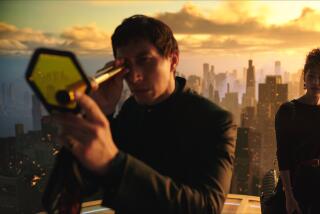MOVIE REVIEW : âDraculaâ: Letting the Blood Flow
Theyâre calling it âBram Stokerâs Dracula,â but Francis Ford Coppolaâs retelling of that sturdy vampire tale turns out to be under the unexpected influence not of the original novel but something equally British, much more modern and decidedly less serious: the comically absurd sensibility of the Monty Python troupe.
Though a bit of the laughter it draws was clearly planned, far too much of this muddled âDraculaâ is silly in a way no one could have intended or anticipated. While Coppola and screenwriter James V. Hartâs much-publicized idea of telling this story of endless love and bloody death in a hot new way that reflected the old novelâs neglected themes sounded promising, it has resulted in a film that is not particularly scary, not very sexy and dramatically over the top.
Despite this, it should be said that âBram Stokerâs Draculaâ (citywide, rated R for sexuality and horror violence) gives off so much overstimulated energy it is anything but dull to look at. Shot by the talented Michael Ballhaus (âGoodfellas,â âThe Fabulous Baker Boysâ), it contains no end of dark and stormy nights filled with pulsating images and bombastic visual effects, not to mention a few grotesque encounters of the âExorcistâ kind.
But the sensibility behind all this activity, like the sensibility that drives the drama, is finally of the comic book variety, pulpy but uninvolving. Though Hart, echoing the original novel, has set âDraculaâ in 1897 London and structured it around the multiple points of view of the diaries and letters of its participants, none of these people turn out to be very interesting. And director Coppola, in an understandable quid pro quo, does not appear to be very interested in them.
Coppola, whose own career seems to be in a perpetual state of resurrection, has been quoted as saying that in making this âDraculaâ he, âdidnât really want to get myself involved in one of those movies that becomes some kind of whole personal experience for myself.â What he wanted was the kind of hit that would enable him to get financing for one of those close-to-the-heart films, and as a result he seems to have made choices for box-office reasons that did not always work out as heâd intended.
Chief among these was the decision to cast the film young, going for stars like Keanu Reeves and Winona Ryder, as well as lesser-known youthful actors like Cary Elwes, Bill Campbell and British newcomer Sadie Frost. A perfectly defensible idea, but, given the fact that almost none of these people look comfortable in their period costumes or sound at ease in their earnest accents, the result tends to feel like a $40-million high school play.
Saddest case is Keanu Reeves, who (after a prologue detailing how the original 15th-Century Dracula began his ungodly ways) starts things off as young law clerk Jonathan Harker, sent by his firm to Transylvania to help a certain count complete the purchase of Londonâs decrepit Carfax Abbey. His intended, the very proper Mina Murray (Ryder), is upset about the inevitable wedding delay, but vows to be patient until he returns.
As if having to say lines like âI say, is the castle far?â wasnât hard enough for poor Reeves/Harker, he is confronted with the Count (Gary Oldman), looking like a refugee from âStar Trekâ in layers of facial latex, the worldâs largest red bathrobe and butterfly-shaped hair. âI am the last of my kind,â he mumbles in a Romanian accent so thick and authentic it is often hard to understand. One of the few things that gets the Count excited is a glimpse of a photo of Mina, who turns out to be, yes, a dead ringer for his first love, gone these 400 years but clearly not forgotten.
Leaving Harker in the clutches of a trio of topless vampirettes who seem to have wandered in off the set of an old Russ Meyer movie, Dracula makes the voyage to London, where he not only loses years off his complexion but, in long flowing hair, top hat and blue granny glasses, changes his identification to Prince Vlad and his intergalactic look to that of a hip roadie for the Grateful Dead.
While Harker has been away ever so long on business, Mina has been staying with her lascivious girlfriend Lucy Westenra (Frost), who enjoys peeking at racy books while teasing her trio of ineptly comic suitors ranging from a wealthy nobleman (Elwes) to a ridiculous Texan (Campbell) to Seward (Richard E. Grant), the head of a lunatic asylum who seems easily as loony as any of his charges.
This antic tone is amplified by Tom Waitsâ game but foolish performance as Renfield, one of the Countâs earliest victims, and, surprisingly, by Anthony Hopkins as Abraham Van Helsing, implacable foe of the undead, who was apparently encouraged to give a loose and jokey performance as the worldâs foremost vampire slayer. Whenever this âDraculaâ makes a stab at being frightening or tries to amplify its romantic theme of a love between Mina and the Count that has survived over centuries, this broad humor persistently undercuts its best efforts.
It may be that Coppolaâs enthusiastic embracing of a fresh approach to a story that has had no difficulty pleasantly chilling moviegoers for a full 70 years was suspect to begin with. It perhaps signaled a director who saw himself as too limited by mere genre material, who, to save himself from feeling he was slumming, decided that he really wasnât making a horror film after all, but rather a love story, a comic burlesque, a costume drama, a piece of erotica, whatever. But no matter what else you do with it, a âDraculaâ that cannot manage to be more scary than silly is as pitilessly doomed as that elegant old Transylvanian himself.
âBram Stokerâs Draculaâ
Gary Oldman: Dracula
Winona Ryder: Mina
Anthony Hopkins: Abraham Van Helsing
Keanu Reeves: Jonathan Harker
Sadie Frost: Lucy Westenra
Richard E. Grant: Dr. Jack Seward
Tom Waits: Renfield
An American Zoetrope/Osiris production, released by Columbia Pictures. Director Francis Ford Coppola. Producers Francis Ford Coppola, Fred Fuchs, Charles Mulvehill. Executive producers Michael Apted, Robert OâConnor. Screenplay James V. Hart, from the novel by Bram Stoker. Cinematographer Michael Ballhaus. Editors Nicholas C. Smith, Glen Scantlebury, Anne Goursaud. Costumes Eiko Ishioka. Music Wojciech Kilar. Production design Thomas Sanders. Running time: 2 hours, 3 minutes.
MPAA-rated R (sexuality and horror violence).
More to Read
Only good movies
Get the Indie Focus newsletter, Mark Olsen's weekly guide to the world of cinema.
You may occasionally receive promotional content from the Los Angeles Times.











